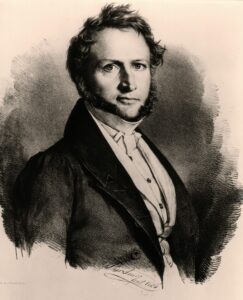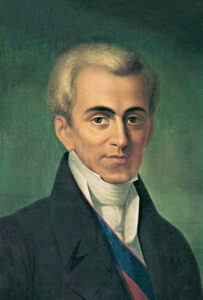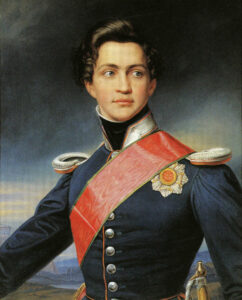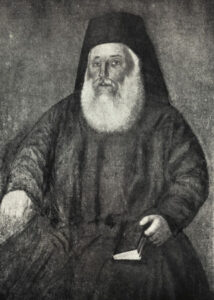The Greek War of Independence began 200 years ago, in 1821, and one of the big consequences of the war was the estrangement of the Orthodox Church in revolutionary Greece from its mother church of Constantinople. From the beginning of the revolution until 1833, the ecclesiastical situation in Greece was kind of a mess. (It didn’t exactly improve after 1833, but it was a more organized mess, as we will see.) A contemporary writer, John Mason Neale, describes the Church as having been “rent in pieces by schism. There were Canonical Bishops, i.e., those consecrated by the Patriarch under the old regime, to the number of twenty-two; un-canonical Bishops, i.e., Prelates consecrated during the war of freedom, without the license of Constantinople, twelve in number; and besides these, about twenty ex-Bishops, deprived of their Sees by the troubles of the times, and who now clamoured loudly for place and maintenance.”
Ioannis Kapodistrias, the former Russian Foreign Minister, took office as the first President of Greece in early 1828. Kapodistrias was a devout Orthodox Christian and he tried to improve relations between the Church of Greece and the Ecumenical Patriarchate, although the relationship remained quite strained. In the fall of 1831, Kapodistrias was assassinated while entering a church. Historian Paschalis Kitromilides writes, “Kapodistrias’s murder in September 1831 was not only a great tragedy for the Greek state but also a tragedy for the future of relations between the church in Greece and the church of Constantinople. His approach to the ecclesiastical question was probably the only guarantee for a smooth settlement.”
***
In the wake of Kapodistrias’s assassination, the Great Powers of Russia, Britain, and France, in their paternalistic way, decided to unilaterally appoint a monarch to rule over Greece. In May of 1832, they selected a teenage Bavarian prince, Otto, as the first King of Greece. (Notably, Otto was not an Orthodox Christian but rather a Roman Catholic.) The three Great Powers and the Ottoman Empire then signed the Treaty of Constantinople, concluding, once and for all, the establishment of Greece as an independent state — albeit an “independent” state whose monarch was chosen by the Great Powers. One might ask the question, why did Greece receive a non-Orthodox king, rather than a king from the royal family of Russia? The answer, it seems, is that Tsar Nicholas I was actually opposed to Greece having a king at all. Although he ultimately consented, he refused to allow any of his relatives to be considered for the position.
In February 1833, the new Greek King Otho (who had Hellenized his name) arrived in his new kingdom aboard an English frigate. Otho was just 17 years old, and for the first two-plus years of his reign, Greece was actually ruled by a regency of three German officials appointed by Otho’s father, King Ludwig of Bavaria. In a sense, the Greeks had simply traded overlords, replacing the Muslim Ottomans with the Roman Catholic and Protestant Germans. But the initial reception of Otho by the Greek people was one of jubilation, as described by a Russian diplomat who was present:
The entry of the king was as solemn and brilliant as it could be in Greece. Everything contributed in a most pleasing way. Nature and men reunited by a common accord to join in the splendor of the spectacle. The Greek people show a joy, an enthusiasm that matches perfectly this imposing pomp and the appearance of the young king, filled with dignity and grief, who just offered his salute to an unhappy people torn by anarchy and filled with hopes for the future. Doubtlessly, this day will be well remembered in the annals of Greece. All of the Greeks appear to have this sentiment more or less. The people are filled with confidence in the authority of the king.
With Greece securely established as an independent state, the new government turned its attention to the Church of Greece, which had been estranged from the Ecumenical Patriarchate since 1821 and was both practically disorganized and canonically suspect. In March, the Regency created a special commission of clergy and laity to assess the state of church life. Leading the project were two men: the German Protestant regent Georg von Maurer, and the nationalistic Greek Orthodox theologian Fr Theocletos Pharmakides. The commission held 11 meetings between April 17 and May 2, deciding that Greece should have an autocephalous church led by a Holy Synod. At the end of May, the commission sent a survey to all of the bishops of Greece, asking for their views on the question of autocephaly. The bishops overwhelmingly supported it.
King Otho, the Bavarian regents, and Fr Pharmakides all agreed that the church should be both independent of Constantinople and subordinate to the government. Pharmakides and the regent Maurer drafted a church constitution to enshrine these principles, and this constitution was presented to an assembly of all the bishops of Greece in July. Article 1 declared “the perfect independence of the Greek Church from any outward power or influence,” and Article 2 called for the creation of a Holy Synod “which should form the supreme ecclesiastical authority, in imitation of the Russian Church.” The primate of the Church of Greece was not an individual hierarch but the Holy Synod itself, which would be commemorated liturgically. The presidency of the synod belonged to the senior member by date of ordination.

Georg von Maurer, the Bavarian Regent of King Otho and architect of the first church constitution of Greece
While the church constitution provided for a Greek Church independent of any outside ecclesiastical authority, the constitution also drastically weakened the internal authority of the church hierarchy, basically reducing the church to a department of the state, subject to the whims of the king and the government. The state had the power to appoint members to the Holy Synod, and no synodal decision was valid without the signature of the state procurator. Although the bishops ostensibly had authority over the “internal” affairs of the church, these internal affairs were narrowly defined. The government could intervene in many areas that would seem to be obviously internal to the church, such as the scheduling of liturgical services, ordinations of clergy, and the number and boundaries of dioceses. The Holy Synod was forbidden from communicating with any foreign authority without going through the government – including spiritual authorities such as other autocephalous churches. Lucien Frary notes, “The arrangement was modeled on the system of church-state relations prevailing in German Protestant states and Scandinavian kingdoms.” Charles Frazee is more pointed: “If ever a church was legally stripped of authority and reduced to complete dependence on the state, Maurer’s constitution did it to the church of Greece.” Frazee goes on to conclude that, “instead of helping the church to make the necessary internal improvements, Maurer’s Constitution simply made it an agency of an authoritarian state and a poor one at that. On this score, Georg von Maurer stands condemned.”
At the end of the hierarchical assembly, the bishops formally requested that the government declare the Church of Greece to be “free and independent of every other power,” with only Christ as its head. On July 23/August 4, the Greek state issued a declaration of the independence of the Church of Greece, which included the church constitution drafted by Maurer and Pharmakides. The Regency government, which was quite out of touch with the realities of the Orthodox Church, naively expected the Ecumenical Patriarchate to simply agree to the new arrangement in Greece. In fact, Patriarch Constantius’s reaction was quite the opposite, and it was only thanks to Tsar Nicholas’s intervention that the Ecumenical Patriarch did not excommunicate the entire Church of Greece.
In the days that followed the declaration of independence, the first Holy Synod of Greece was appointed, chaired by Metropolitan Kyrillos of Corinth. The synod’s secretary was Fr Pharmakides, one of the architects of the constitution. The government declared July 27 (Julian) a national holiday to celebrate the new constitution.
***
While the hierarchs were being stripped of their authority, the state of local parish life in Greece in this period was also quite abysmal. Thousands of clergy had died, almost half of the metropolises had no bishop, and the vast majority of priests were illiterate. Countless churches had been destroyed in the war, and priests frequently served liturgies without the proper books and liturgical items. Protestant missionaries exploited the weakened state of the Orthodox Church by introducing heretical doctrines and trying to convert the Orthodox faithful.
Two months after the declaration of church independence, the Greek government ordered that all monasteries with fewer than six monks be dissolved. This resulted in the closure of 412 of the 560 monastic communities in Greece, and their property was to be confiscated by the state. The remaining monasteries were subjected to taxation. Two months later, the government decreed that henceforth Greece would have only ten bishops, one for each of the ten territorial “nomes” of the country. In fact there were some forty bishops in Greece at the time, most of them refugees from the Ottoman Empire whose diocesan sees lay outside of Greece. The government’s plan was to appoint multiple bishops to each “nome” and then to wait for them to die off, eventually resulting in ten bishops in the country.
In 1834, the new Holy Synod of Greece made several efforts to regulate monastic life. In January, to deal with the problem of rogue monks who wandered the country, the synod issued a decree requiring monks to have a blessing from the local bishop before preaching outside of their monastery. Weddings and baptisms in monasteries were banned, and rules were laid down for the election of abbots. Monasteries were required to submit detailed reports to the government. In September, the government began implementation of the previous year’s decision to close small monasteries and confiscate their landholdings.
***
The next decade was one of division and discontent. In the late 1830s, a conspiracy known as the “Philorthodox Society” was organized in an effort to re-submit the Church of Greece to the Ecumenical Patriarchate and to either force King Otho to convert to Orthodoxy or replace him with an Orthodox monarch. Meanwhile, Greece continued to be the target of Protestant missionaries from Britain and America.
In September 1843, a group of soldiers and citizens rebelled against the government, forcing Otho to grant a constitution, which was formally proclaimed in March 1844. The second article affirmed the autocephaly of the Church of Greece, but, to the great disappointment of the more traditional members of the Church, it failed to expand the Church’s independence from the state compared to the much-maligned 1833 church constitution, which remained in force. It also stopped short of requiring King Otho to become Orthodox, only providing that future monarchs must be members of the Church.
During this period, the relationship between the Church of Greece and the Ecumenical Patriarchate remained unresolved, with the Phanar continuing to reject Greek autocephaly and the Church of Greece refusing to submit to the Patriarchate. In February 1850, King Otho decided to award Ecumenical Patriarch Anthimus IV the Order of the Holy Savior, and he sent an archimandrite from the Church of Greece to deliver the honorary cross. The Greek envoy also brought a letter from the Holy Synod of Greece to the Patriarch. This was a very subtle attempt to get the Patriarch to acknowledge the Greek Holy Synod as a legitimate institution. But, as Fr Theocletos Pharmakides wrote shortly afterward, “Anthimus was too astute a politician to be entrapped by arts in which he himself knew no superior.” With the Sultan’s permission, Anthimus accepted the honor from King Otho, but he refused to so much as touch the letter from the Holy Synod, saying that “he knew nothing about a Church of Hellas.”
Ultimately, though, both sides wanted to find a way to normalize the situation. The Greek Synod sent additional letters, and in June Patriarch Anthimus called a meeting of the Holy Synod of Constantinople, which concluded with the decision, “It seemed good to the Great and Holy Synod to free the metropolitan, archiepiscopal, and episcopal sees at present forming the Hellenic realm, dependent until now upon the most holy Oecumencial See of Constantinople, from such dependence in the future, and to proclaim them an independent Church on certain most just and necessary conditions.” Notably, the Patriarchate claimed that the Church of Greece had, up to that very moment, remained dependent upon the Patriarchate.
On June 28, the Ecumenical Patriarchate issued a tomos of autocephaly to the Church of Greece, signed by not only the sitting Ecumenical Patriarch but also five of his predecessors as well as the Patriarch of Jerusalem, along with thirteen other bishops. In addition to recognizing Greece’s autocephaly only from that point forward, the tomos imposed certain conditions on the Church of Greece: the Ecumenical Patriarch must be commemorated at the Divine Liturgy and must be the provider of Holy Chrism, and the Church of Greece must submit all important questions to the Ecumenical Patriarchate.
Many in the Church of Greece were horrified at these conditions. Fr Pharmakides, one of the architects of the original independence of the Church of Greece in the 1830s, railed against the tomos of autocephaly, writing a book denouncing the tomos as a betrayal of Greek independence.
***
The Church of Greece was now “autocephalous,” at least in name. But it was an unsatisfying “autocephaly.” In practice, the Church remained under the thumb of the Roman Catholic King Otho and the Greek government. And while the tomos of autocephaly might be viewed as capitulation by the Ecumenical Patriarchate, the actual terms of the tomos were arguably a boon to the Patriarchate, which re-acquired a not-insignificant measure of its old authority over the Church of Greece.
Main Sources
The Portfolio: A Collection of State Papers and Other Documents and Correspondence, Historical, Diplomatic, and Commercial, Vol. IV. (London: Frederic Shoberl, 1836).
Lucien J. Frary, Russia and the Making of Modern Greek Identity 1821-1844 (Oxford University Press, 2015).
Charles A. Frazee, The Orthodox Church and Independent Greece 1821-1852 (Cambridge University Press, 1969).
Paschalis M. Kitromilides, “The legacy of the French Revolution: Orthodoxy and nationalism” in Cambridge History of Christianity, Volume 5: Eastern Christianity (2008), 229-249.
Paschalis M. Kitromilides and Constantinos Tsoukalas, eds., The Greek Revolution: A Critical Dictionary (Cambridge, MA and London: The Belknap Press of Harvard University Press, 2021).
William Miller, The Ottoman Empire and Its Successors: 1801-1927 (New York: Octagon Books, 1966) (reprint of 3rd edition published in 1927).
Fr Theocletos Pharmakides, “The Ecclesiastical Independence of Greece,” Methodist Quarterly Review (Oct. 1857).



This is an excellent account of the intervention of the western powers in the affairs of the churches of Greece and Constantinople during the e nineteenth century. In my opinion, a similar process is under way today with American officials pushing these two churches to recognize the pseudo bishops of Ukraine. It is surprising that both the synods of Greece and Constantinople appear to have forgotten this history. Constantinople was in the right during the nineteenth century and is in the wrong today. Constantinople today has joined the west in doing to the Russian church what the western powers did to the church of Constantinople two centuries ago.
The events recounted in the article above explain the dysfunction in the Greek speaking churches today and show a disturbing precedent for the crisis in orthodoxy today.